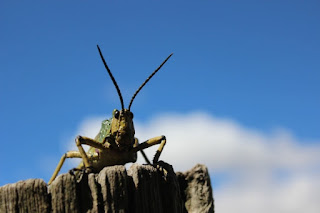Mount St Helens, Arthropods, and the Genesis Flood
One way to feel small is to look up into the night sky at the vastness of the heavens, then be amazed that the Creator cares about us (Psalm 8:3-5). Something less profound but still interesting is how we are outnumbered by arthropods, comprising eighty-four percent of living creatures.
Arthropods come in a huge variety such as crabs, lobsters, insects, and so on. The Master Engineer designed them to populate and repopulate ecosystems. One dramatic example of this is in the aftermath of the 1980 Mount St. Helens eruption.
 |
| Grasshopper, Unsplash / Clara Metivier Beukes |
Before climbing that mountain, there are some things that should be noted. It is entirely reasonable to expect claims of biblical creationists regarding the global Flood to be supported by physical evidence. This weblog has hundreds of such posts that link to creation science articles on that subject, so that's not a difficulty.
Creationists make some big claims about the devastation of the Flood, and those are supported. (Misotheists reject the Flood out of hand because of materialistic presuppositions, and they refuse to even consider the evidence. It's wrong. Reasons and stuff.) But we need to look at the elephant on the Ark.
Here we are, the world is turning, lots of critters and billions of humans. The world had to recover from the astonishing amount of devastation, so is there any compelling scientific evidence for post-Ark animal dispersal and repopulation?
Creation scientists and their secular counterparts examine evidence and conditions for repopulation after devastation and what they call disturbances. Volcanoes do far more than disturb the neighbors, and they have a major role in creation science Flood models. Studying many aspects of history and biology is important.
Mount St. Helens has provided a wealth of information on many things, including repopulation after disturbances. We know the climate of the area, conditions that the eruption caused, and how living things came back. One might think that plants were the first to reappear, but it was probably arthropods. In this case, insects. Their return to the area is one of several supporting evidences for creation science Flood models.
Noah’s Flood was the greatest ecological disturbance in earth history, and yet Earth’s biota subsequently recovered, demonstrating remarkable resilience. In similar manner, the 1980 eruption of Mount St Helens in Washington State, USA, severely disrupted a large ecosystem, the responses of which have been, and continue to be, observed and documented. General mechanisms of disturbance and principles of recovery have been delineated, which likely apply to other large disturbances, including Noah’s Flood. Therefore, lessons learned at Mount St Helens should assist biblical creationists in constructing a model for post-Noahic Flood biological recovery. This article looks at one facet of the Mount St Helens eruption—the impact on arthropods and their subsequent responses to disturbance, including the following topics: high mortality, biological legacies, dispersal, role in primary succession, enrichment of developing soils, alteration of successional trajectories, and great resilience. Implications for a post-Noahic Flood recovery model are discussed.
Although rather technical, but less scientifically-inclined readers can learn from it. You can finish reading over at "Arthropod responses to the 1980 eruption of Mount St Helens—implications for Noahic Flood recovery." Another one that may blow your hair back is "Amphibians Support the Genesis Flood", which is about how those critters came back to the Mount as well.